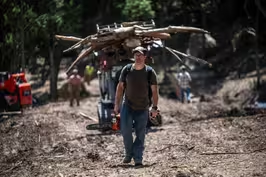
Why some of the most populous cities in the U.S. are sinking
Clip: 7/13/2025 | 5m 12sVideo has Closed Captions
‘Slow motion crisis’: Why some of the most populous cities in the U.S. are sinking
According to a recent study published in the journal Nature Cities, 28 of the most populous U.S. cities are sinking. It’s due to a phenomenon called land subsidence, exacerbated in many cases by humans extracting too much groundwater from underground aquifers. Ali Rogin speaks with Grist senior writer Matt Simon to learn more.
Problems playing video? | Closed Captioning Feedback
Problems playing video? | Closed Captioning Feedback
Major corporate funding for the PBS News Hour is provided by BDO, BNSF, Consumer Cellular, American Cruise Lines, and Raymond James. Funding for the PBS NewsHour Weekend is provided by...

Why some of the most populous cities in the U.S. are sinking
Clip: 7/13/2025 | 5m 12sVideo has Closed Captions
According to a recent study published in the journal Nature Cities, 28 of the most populous U.S. cities are sinking. It’s due to a phenomenon called land subsidence, exacerbated in many cases by humans extracting too much groundwater from underground aquifers. Ali Rogin speaks with Grist senior writer Matt Simon to learn more.
Problems playing video? | Closed Captioning Feedback
How to Watch PBS News Hour
PBS News Hour is available to stream on pbs.org and the free PBS App, available on iPhone, Apple TV, Android TV, Android smartphones, Amazon Fire TV, Amazon Fire Tablet, Roku, Samsung Smart TV, and Vizio.
Providing Support for PBS.org
Learn Moreabout PBS online sponsorshipJOHN YANG: 28 of the most populous U.S. cities are sinking.
That's according to a recent study published in the journal Nature Cities.
It documents urban areas sinking about a third of an inch a year.
The changes in elevation measured over time by using satellites.
Ali Rogin is back with a conversation with Matt Simon, senior writer at the climate focused news nonprofit Grist.
ALI ROGIN: Matt Simon, thank you so much for being here.
Why are these cities sinking?
MATT SIMON, Senior Writer, Grist: This is a phenomenon known as land subsidence.
This is sometimes a natural phenomenon.
The earth itself sometimes sinks, but the issue here with humans is that we're extracting too much groundwater.
When that happens, think of an aquifer underground, like a water bottle.
You take too much water out and it'll actually crumble.
In a place like Mexico City, up to 20 inches a year of sinking, in the United States, it's a little bit less, but it's still the sort of slow motion crisis that's affording across the country.
ALI ROGIN: What are some of the risks posed to buildings and infrastructure, even when there's a sinking that happens of just a few millimeters?
MATT SIMON: The issue here is something called differential land subsidence, which is where you have not only rates of subsidence happening at different ends of a city, but even different ends of a building.
So when that happens, it destabilizes the foundation cracks and you can some really bad structural problems.
Think of all the roads, levees and things like that, the runways.
It's the differential kind of subsidence that's really the issue here.
ALI ROGIN: And has this been going on for a while now or is this a relatively new phenomenon?
MATT SIMON: Decades and decades, actually.
This has been quite a problem in California in particular, where we have been extracting way too much groundwater for our agriculture.
There are parts of California that have sunk by 30 feet, which is just this giant dimple in the landscape that causes, of course, lots of infrastructural problems.
But also we are starting to think in California and other states that have a lot of agriculture but better ways to manage that water so we don't get so much sinking.
Because it's really hard to actually reinflate that land once it has sunk.
ALI ROGIN: Outside of those agricultural areas.
Are some cities more vulnerable to this than others?
Are there things about the ways individual cities are designed that might make them more vulnerable?
MATT SIMON: Wherever you're extracting too much groundwater, you're going to lose that volume in the earth itself and the land is going to come down.
What you can do is something called managed aquifer recharge, which is in the rainy season, when you have an abundance of water, pump some of that back down into the ground, it can actually reinflate that empty water bottle.
But it's really depending less, I think, on geology and more on water practices city to city across the United States.
ALI ROGIN: And you mentioned some of the solutions that are being employed.
How hard is it to reverse and mitigate these trends?
MATT SIMON: The issue that we're coming up against is that we have pretty severe climate change, especially in the American west, where we have exacerbated droughts.
There is often no choice but to over extract these aquifers because you've got to hydrate people and crops some way.
So we are getting better about managing that water.
We are getting better modeling about how much water we're going to need to use going forward.
Urban populations are booming.
You need to provide water to those people that is often really only going to come from groundwater.
We need better solutions here.
So people might not want to hear this, but there are actually really good and safe ways to recycle wastewater so you can filter it in such a way that it is just extraordinarily pure.
It goes back into the water supply.
Things like green spaces in cities, these help soak up rainwater, lets it soak down into that aquifer and recharges it.
So there are these smaller solutions, but I think we need to have more of a national conversation as climate change unfolds about how we need to get better about, first of all, using water, reducing use, but also finding new ways to reuse and new ways to capture just coming from the sky.
ALI ROGIN: Are there countries that are having success reversing these trends?
MATT SIMON: A place like Jakarta, Indonesia, they have such a huge problem with subsidence that they actually have to move their capital city somewhere else because of all the sinking.
But really, all around the world, we're getting better at managing this water.
I think it was only until recently that scientists started gathering this sort of data with satellites to be able to show exactly where in a city you might have this subsidence.
And that's valuable information for a city to go in and say, okay, we have a problem here.
Let's fix this before seeking really gets out of hand.
What's so important about the science is it's this data that city managers really need to face down this problem.
ALI ROGIN: Matt Simon with Grist.
Thank you so much for breaking this down for us.
MATT SIMON: And thank you for having me.
How Russia used Brazil as a global espionage ‘spy factory’
Video has Closed Captions
Clip: 7/13/2025 | 6m 43s | How Russia used Brazil as a ‘spy factory’ for global espionage (6m 43s)
A look at the controversy around ‘Alligator Alcatraz’
Video has Closed Captions
Clip: 7/13/2025 | 4m 46s | A look at the controversy around ‘Alligator Alcatraz’ detention center (4m 46s)
News Wrap: Palestinian death toll in Gaza passes 58,000
Video has Closed Captions
Clip: 7/13/2025 | 2m 26s | News Wrap: Palestinian death toll in Gaza passes 58,000, officials say (2m 26s)
Search efforts paused by new threat of flooding in Texas
Video has Closed Captions
Clip: 7/13/2025 | 4m 19s | Texas families face grim reality that some missing from floods may not be found (4m 19s)
Providing Support for PBS.org
Learn Moreabout PBS online sponsorshipSupport for PBS provided by:
Major corporate funding for the PBS News Hour is provided by BDO, BNSF, Consumer Cellular, American Cruise Lines, and Raymond James. Funding for the PBS NewsHour Weekend is provided by...















